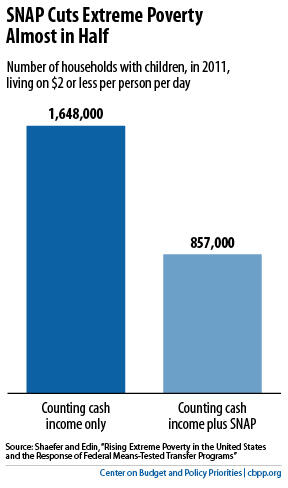off the charts
POLICY INSIGHT
BEYOND THE NUMBERS
BEYOND THE NUMBERS
SNAP and the Fight Against Extreme Poverty
Receive the latest news and reports from the Center
“Food stamp recipients already took a cut in benefits this month, and they may face more [cuts]” as Congress considers slashing program funding, Nicholas Kristof’s latest New York Times column points out. Kristof focuses on the potential impact on children, many of whom the program — now called SNAP — lifts out of extreme poverty, and his column is well worth a look.

Counting SNAP benefits as income cuts the number of households with children in extreme poverty in 2011 by 48 percent, from 1.6 million to 857,000 (see graph).
SNAP also cut, by roughly half, the rise in extreme poverty among households with children between 1996 and 2011, the study found.
One reason SNAP is so effective against extreme poverty is that it focuses its benefits on many of the poorest households. Roughly 91 percent of monthly SNAP benefits go to households below the poverty line, and 55 percent go to households below half of the poverty line (about $9,800 for a family of three). One in five SNAP households lives on cash income of less than $2 per person a day.
Policymakers considering more SNAP cuts should keep in mind that the program keeps more households with children out of extreme poverty than any other government program.